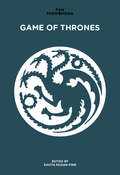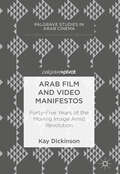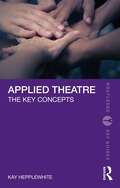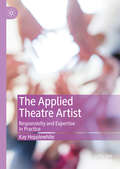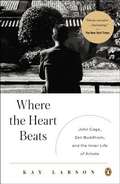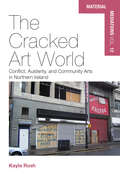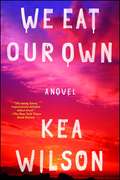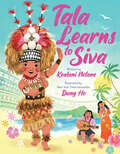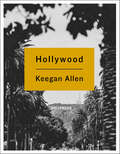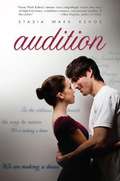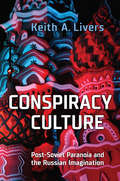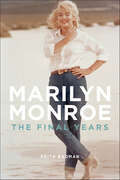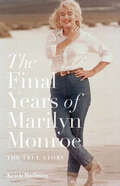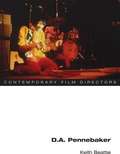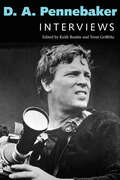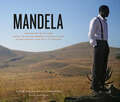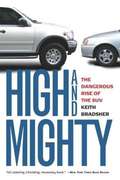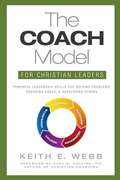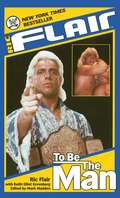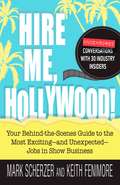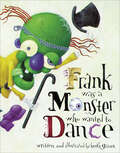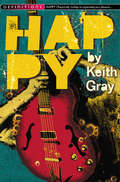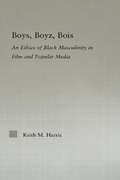- Table View
- List View
Game of Thrones (Fan Phenomena Ser.)
by Kavita FinnWinter is coming. Every Sunday night, millions of fans gather around their televisions to take in the spectacle that is a new episode of Game of Thrones. Much is made of who will be gruesomely murdered each week on the hit show, though sometimes the question really is who won’t die a fiery death. The show, based on the Song of Ice and Fire series written by George R. R. Martin, is a truly global phenomenon. <P><P> With the seventh season of the HBO series in production, Game of Thrones has been nominated for multiple awards, its cast has been catapulted to celebrity, and references to it proliferate throughout popular culture. Often positioned as the grittier antithesis to J. R. R. Tolkien’s Lord of the Rings, Martin’s narrative focuses on the darker side of chivalry and heroism, stripping away these higher ideals to reveal the greed, amorality, and lust for power underpinning them. <P><P> Fan Phenomena: Game of Thrones is an exciting new addition to the Intellect series, bringing together academics and fans of Martin’s universe to consider not just the content of the books and HBO series, but fan responses to both. From trivia nights dedicated to minutiae to forums speculating on plot twists to academics trying to make sense of the bizarre climate of Westeros, everyone is talking about Game of Thrones. Edited by Kavita Mudan Finn, the book focuses on the communities created by the books and television series and how these communities envision themselves as consumers, critics, and even creators of fanworks in a wide variety of media, including fiction, art, fancasting, and cosplay.
Arab Film and Video Manifestos: Forty-Five Years of the Moving Image Amid Revolution (Palgrave Studies in Arab Cinema)
by Kay DickinsonArab Film and Video Manifestos presents, in their entirety, five key documents that have fundamentally shaken up and helped change the face of image culture in the Middle East and beyond. The book collects together, for the first time, these influential, collectively written calls and directives that span a fifty-year period and hail from a range of different countries. Each urges a radical rethinking of film and video’s role in culture, its relation to politics, and its potential to instigate profound change. Kay Dickinson carefully positions the manifestos within their broader socio-historical contexts and provides supplementary reading and viewing suggestions for readers who cannot access Arabic-language sources.
Applied Theatre: The Key Concepts (Routledge Key Guides)
by Kay HepplewhiteThis accessible book outlines the key ideas that define the global phenomenon of applied theatre, not only its theoretical underpinning, its origins and practice, but also providing eight real-life examples drawn from a diversity of forms and settings.The clearly arranged topic sections entitled When, What, Who, Why and Where emphasise the responsive nature of applied theatre, its social context and the importance of a beneficial outcome for participants, which can connect fields as disparate as health, criminal justice, education and migration. Labels and terms are explained, along with applied theatre’s core values, motivations and objectives, allowing the reader to build a coherent understanding of its distinguishing features.Applied Theatre: The Key Concepts is aimed at students, academics, artists and practitioners of applied theatre as well as those with an interest in this vital blend of social and creative practice.
The Applied Theatre Artist: Responsivity and Expertise in Practice
by Kay HepplewhiteThis book analyses the work of applied theatre practitioners using a new framework of ‘responsivity’ to make visible their unique expertise. In-depth investigation of practice combines with theorisation to provide a fresh view of the work of artists and facilitators. Case studies are drawn from community contexts: with women, mental health service users, refugees, adults with a learning disability, older people in care, and young people in school. Common skills and qualities are given a vocabulary to help define applied theatre work, such as awareness, anticipation, adaptation, attunement, and responsiveness. The Applied Theatre Artist is of scholarly, practical, and educational interest. The book offers detailed analysis of how skilled theatre artists make in-action decisions within socially engaged participatory projects. Rich description of in-session activity reveals what workshop facilitators actually do and how they think, offering a rare focus in applied theatre.
Where the Heart Beats: John Cage, Zen Buddhism, and the Inner Life of Artists
by Kay LarsonA “heroic” and “fascinating” biography of John Cage showing how his work, and that of countless American artists, was transformed by Zen Buddhism (The New York Times) Where the Heart Beats is the story of the tremendous changes sweeping through American culture following the Second World War, a time when the arts in America broke away from centuries of tradition and reinvented themselves. Painters converted their canvases into arenas for action and gesture, dancers embraced pure movement over narrative, performance artists staged “happenings” in which anything could happen, poets wrote words determined by chance. In this tumultuous period, a composer of experimental music began a spiritual quest to know himself better. His earnest inquiry touched thousands of lives and created controversies that are ongoing. He devised unique concerts—consisting of notes chosen by chance, randomly tuned radios, and silence—in the service of his absolute conviction that art and life are one inseparable truth, a seamless web of creation divided only by illusory thoughts. What empowered John Cage to compose his incredible music—and what allowed him to inspire tremendous transformations in the lives of his fellow artists—was Cage’s improbable conversion to Zen Buddhism. This is the story of how Zen saved Cage from himself. Where the Heart Beats is the first book to address the phenomenal importance of Zen Buddhism to John Cage’s life and to the artistic avant-garde of the 1950s and 1960s. Zen’s power to transform Cage’s troubled mind—by showing him his own enlightened nature—liberated Cage from an acute personal crisis that threatened everything he most deeply cared abouthis life, his music, and his relationship with his life partner, Merce Cunningham. Caught in a society that rejected his art, his politics, and his sexual orientation, Cage was transformed by Zen from an overlooked and marginal musician into the absolute epicenter of the avant-garde. Using Cage’s life as a starting point, Where the Heart Beats looks beyond to the individuals Cage influenced and the art he inspired. His creative genius touched Robert Rauschenberg, Jasper Johns, Andy Warhol, Yoko Ono, Alan Kaprow, Morton Feldman, and Leo Castelli, who all went on to revolutionize their respective disciplines. As Cage’s story progresses, as his collaborators’ trajectories unfurl, Where the Heart Beats shows the blossoming of Zen in the very heart of American culture. .
The Cracked Art World: Conflict, Austerity, and Community Arts in Northern Ireland (Material Mediations: People and Things in a World of Movement #12)
by Kayla RushThis book presents a nuanced view of Northern Ireland, a place at once deeply mired in its past and seeking to forge a new future for itself as a ‘post-post-conflict’ place within the context of a changing United Kingdom, a disintegrating Europe, and a globalized world. This is a Northern Ireland that is conflicted, segregated, and marginalized within modern Europe, but also hopeful and forward looking, seeking to articulate for itself a new place in the contemporary world.
We Eat Our Own: A Novel
by Kea WilsonAn ambitious debut novel by an original young writer, We Eat Our Own blurs the lines between life and art with the story of a film director's unthinkable experiment in the Amazon.When a nameless, struggling actor in 1970s New York gets the call that an enigmatic director wants him for an art film set in the Amazon, he doesn't hesitate: he flies to South America, no questions asked. He quickly realizes he's made a mistake. He's replacing another actor who quit after seeing the script--a script the director now claims doesn't exist. The movie is over budget. The production team seems headed for a breakdown. The air is so wet that the celluloid film disintegrates. But what the actor doesn't realize is that the greatest threat might be the town itself, and the mysterious shadow economy that powers this remote jungle outpost. Entrepreneurial Americans, international drug traffickers, and M-19 guerillas are all fighting for South America's future--and the groups aren't as distinct as you might think. The actor thought this would be a role that would change his life. Now he's worried if he'll survive it. Inspired by a true story from the annals of 1970s Italian horror film, and told in dazzlingly precise prose, We Eat Our Own is a resounding literary debut, a thrilling journey behind the scenes of a shocking film and a thoughtful commentary on violence and its repercussions.
Tala Learns to Siva
by Kealani NetaneA lovingly empowering story about finding courage and strength in your family, history, and community through a traditional and cherished Samoan dance, taualuga. Written by debut author, Kealani Netane, and illustrated by New York Times bestselling illustrator, Dung Ho. <P><P> Tala wishes that she could dance the traditional Samoan dance, the taualuga, just like her Aunty Sina. But Tala's legs are too bouncy, her arms are too stiff, and she doesn't have Aunty's 'glow' when she dances. When Tala prepares to perform at her Grandma's birthday, she freezes on the stage. Will she find the strength and inspiration to help her dance? <P><P> Newcomer Kealani Netane crafts a heartwarming story about finding your inner strength through the love and guidance of your family. New York Times bestselling illustrator Dung Ho's cheerful colors and sweet characters bring this loving story to life, making this the perfect gift for little ones who are learning how to follow their hearts and make their own paths. <P><P><i>Advisory: Bookshare has learned that this book offers only partial accessibility. We have kept it in the collection because it is useful for some of our members. Benetech is actively working on projects to improve accessibility issues such as these.</i>
The Sociolinguistics of South African Television: Language Ideologies in Selected Case Studies
by Kealeboga AisengThis book explores the interwoven relationship between language, media, and society in post-Apartheid South Africa. The author examines selected case studies from the sociolinguistic landscape of South African television, analysing dominant language ideologies and illuminating the challenges, opportunities, and potential for transformation. He argues for the power of television in shaping language ideologies, fostering cultural understanding, and advocating for more inclusive and equitable language usage in the media. This book contributes to the field of sociolinguistics by emphasizing the complexity of multilingualism in South Africa and inviting ongoing exploration and dialogue in this landscape. It will be of interest to students and scholars of Sociolinguistics, Media Studies, African Culture and History, and Language Policy and Planning.
Hollywood: Photos and Stories from Foreverland
by Keegan AllenA photographic tour of the different sides of Hollywood by the the bestselling author of life.love.beauty.The actor, photographer, and bestselling author reveals the Hollywood we see--and the one we don't--with a photography narrative featuring more than 250 emotionally charged color and black and white photos. Keegan Allen is a Hollywood native, growing up in a world that millions visit and many more imagine. With an avid fan base that follows him on Facebook, Instagram, Twitter, Snapchat, and a busy career that includes seven years on the hit series Pretty Little Liars as well as films directed by James Franco and Gia Coppola, Allen also is a lifelong photographer whose first book, life.love.beauty, was a national bestseller. Now Keegan turns his eye and camera to the place he knows best. Hollywood captures the beauty and glamour of the place itself—with unusual angles of the famous sign, the glint of sidewalk stars stamped into the entrance of the Grauman’s TCL Chinese Theater in the rain, the Chateau Marmont at twilight, secret local hideaways, red carpets and more--but also the darker side of dreams unrealized in the faces, hands, eyes, and footsteps of those who live on the fringe of celebrity. His photos are enhanced by revealing, intimate captions, lyrics, and other writing, as well as hand-drawn illustrations, exciting parodies, and iconic emulations. A book that will engage and surprise Keegan's legions of fans and followers, Hollywood is an essential gift for anyone who has visited or imagined this storied place.
Audition
by Kehoe Stasia WardWhen high school junior Sara wins a coveted scholarship to study ballet, she must sacrifice everything for her new life as a professional dancer-in-training. Living in a strange city with a host family, she's deeply lonely-until she falls into the arms of Remington, a choreographer in his early twenties. At first, she loves being Rem's muse, but as she discovers a surprising passion for writing, she begins to question whether she's chosen the right path. Is Rem using her, or is it the other way around? And is dancing still her dream, or does she need something more? This debut novel in verse is as intense and romantic as it is eloquent. .
Conspiracy Culture: Post-Soviet Paranoia and the Russian Imagination
by Keith A. LiversContemporary Russia stands apart as one of the most prolific generators of conspiracy theories and paranoid rhetoric. Conspiracy Culture traces the roots of the phenomenon within the sphere of culture and history, examining the long arc of Russian paranoia from the present moment back to earlier nineteenth-century sources, such as Dostoevsky’s anti-nihilist novel Demons. Conspiracy Culture examines the use of conspiracy tropes by contemporary Russian authors and filmmakers including the postmodernist writer Viktor Pelevin, the conservative author and pundit Aleksandr Prokhanov, and the popular director Timur Bekmambetov. It also explores paranoia as an instrument within contemporary Russian political rhetoric, as well as in pseudo-historical works. What stands out is the manner in which popular paranoia is utilized to express broadly shared fears not only of a long-standing anti-Russian conspiracy undertaken by the West, but also about the destruction of the country’s cultural and spiritual capital within this imagined "Russophobic" plot.
Marilyn Monroe: The Final Years
by Keith BadmanPublished for the fiftieth anniversary of her tragic death, this definitive account dispels the rumors and sets the record straight on her last two yearsMarilyn Monroe passed away at the age of thirty-six under circumstances that have remained mysterious to this day. Marilyn Monroe: The Final Years separates the myths and rumors from the facts as Keith Badman takes readers through the concluding months of 1960 to that fateful day in August 1962. In this extraordinary book—the product of five years of exhaustive research—the author is both biographer and detective: Badman uncovers long-lost or previously unseen personal records, exclusive interviews, and eyewitness accounts that illuminate the final chapter of Marilyn's life as she navigates weight gain, drug use, an dpersonal turmoil, along with drama on the set of the ill-fated movie Something's Got to Give. Badman dispels popular beliefs, such as her supposed affairs with John and Bobby Kennedy. (Monroe only had a one-night stand with the president at Bing Crosby's house, and never with Bobby.) Readers learn the long-concealed identity of her biological father, who refused Marilyn's attempt to contact him in 1951—and was then repaid with her apathy ten years later when he attempted to contact her. The author also reveals the details of her famous "last Sitting" with photographer Bert Stern (which was not her last photo shoot) and describes the horror she endured after being tricked into being institutionalized at the Payne-Whitney Psychiatric Clinic, from which ex-husband Joe DiMaggio had to pull strings to secure her release. Perhaps most shockingly, we learn of the regrettable incident in which a drunken Monroe was sexually exploited by mobsters at a Lake Tahoe hotel co-owned by Frank Sinatra. Finally contrary to the salacious rumors that Marilyn was suicidal or the victim of a murder and cover-up, Badman discloses new information about her final days alive and reveals, in unequivocal detail, evidence that indicates Monroe's death was accidental. Above it all, Badman pays homage to Monroe by rescuing her final months from the realm of wild and sensationalized allegations popularized by those who sought to gain from them. Marilyn Monroe: The Final Years sheds new light on an immortal movie legend.
The Final Years of Marilyn Monroe: The True Story
by Keith BadmanThis “extraordinary” account of the superstar’s tragic death, and what led up to it, is “a relentless and detailed quest for the truth” (Lancashire Post).In his illuminating, fascinating book, Keith Badman finally uncovers the truth about the iconic actress’s last years. It was a tough time—one in which Marilyn Monroe’s increasingly erratic behavior and dependence on alcohol and medication plunged her glittering movie career into drastic decline. Meticulously researched, the book reveals precisely how Monroe died at just thirty-six years of age, and shines a light on the suspicious delays on the night of her overdose—delays that indicate a cover-up. He discovers new details about her rekindled relationship with Joe DiMaggio, and the horrendous weekend she spent at Frank Sinatra’s Cal-Neva lodge, as well as why Fox refused to let her finish her final movie, Something’s Got to Give, and her distress at being imprisoned at the Payne Whitney psychiatric hospital.Drawing on private, previously unpublished itineraries and original eyewitness accounts, Badman sheds new light on Marilyn’s involvement with John and Bobby Kennedy, and ends a six-decade-old mystery by telling the precise date of her first encounter with the president. The Final Years of Marilyn Monroe features a deluge of stories of which even die-hard fans will be unaware.“[A] nearly day-by-day account of her life from June 1961 to her death in August 1962.” —Kirkus ReviewsIncludes photos
D.A. Pennebaker (Contemporary Film Directors)
by Keith BeattieThis volume is the first book-length study of the extensive career and prolific works of D.A. Pennebaker, one of the pioneers of direct cinema, a documentary form that emphasizes observation and a straightforward portrayal of events. With a career spanning decades, Pennebaker's many projects have included avant-garde experiments (Daybreak Express), ground-breaking television documentaries (Primary), celebrity films (Dont Look Back), concert films (Monterey Pop), and innovative fusions of documentary and fiction (Maidstone). Exploring the concept of "performing the real," Keith Beattie interprets Pennebaker's films as performances in which the act of filming is in itself a performative transgression of the norms of purely observational documentary. He examines the ways in which Pennebaker's presentation of unscripted everyday performances is informed by connections between documentary filmmaking and other experimental movements such as the New American Cinema. Through his collaborations with such various artists as Richard Leacock, Shirley Clarke, Norman Mailer, and Jean-Luc Godard, Pennebaker has continually reworked and redefined the forms of documentary filmmaking. This book also includes a recent interview with the director and a full filmography.
D. A. Pennebaker: Interviews (Conversations with Filmmakers Series)
by Keith Beattie and Trent GriffithsThis wide-ranging and insightful collection of interviews with D. A. Pennebaker (b. 1925) spans the prolific career of this pioneer of observational cinema. From the 1950s to the present day, D. A. Pennebaker has made documentary films that have revealed the world of politics, celebrity culture, and the music industry. Following his early collaborations with Robert Drew on a number of works for television, his feature-length portrait of Bob Dylan on tour in England in 1965 (the landmark film Dont Look Back) established so-called direct cinema as a form capable of achieving broad theatrical release. With Monterey Pop, Pennebaker inaugurated the popular mode of rock concert film (or "rockumentary"), a style of filmmaking he has expanded on through a number of films, including Ziggy Stardust and the Spiders from Mars and Depeche Mode: 101.Pennebaker has always regarded collaboration as an integral part of his filmmaking methods. His long-running collaboration with Richard Leacock and subsequently his work with Chris Hegedus have enriched his approach and, in the process, have instituted collaboration as a working practice integral to American direct cinema. His other collaborations, particularly those with Jean-Luc Godard and Norman Mailer, resulted in innovative combinations of observational techniques and fictional aesthetics. Such films as The War Room, which was about the 1992 Democratic primaries and was nominated for an Academy Award, and the 2009 Kings of Pastry continue to explore the capacities of observational documentary. In 2012 Pennebaker was the first documentary filmmaker to be awarded an Academy Honorary Award by the Academy of Motion Picture Arts and Sciences.
Mandela: A Film and Historical Companion
by Keith BernsteinThis official companion book to the epic major feature film Mandela: Long Walk to Freedom retraces the life of Nelson Mandela, weaving together his own words and historic humanitarian efforts with cinematic narrative and exclusive behind-the-scenes content. It's a movie tie-in unlike any other: a combination of dramatic recreations and history, featuring film stills alongside archival photographs of actual events; commentary from the acclaimed cast and filmmakers plus interviews with Mandela's own family and comrades; excerpts from his books and personal papers, with lush, full-color panoramas of the South African landscapes where the film was shot on location. Fans of the movie and Mandela admirers, whatever their age, will relish this unique look at the making of an epic motion picture and the life of a beloved historical icon.
High and Mighty: The Dangerous Rise of the SUV
by Keith BradsherFrom the book: Sport utility vehicles have taken over America's roads - pushing fuel consumption up and traffic safety down. Keith Bradsher has long been at the forefront of critical SUV coverage and in HIGH AND MIGHTY he delivers a thorough, undeniable indictment of these vehicles as much worse than cars for their occupants, for other motorists, for pedestrians, and for the planet itself. This masterpiece of investigative j'ournalism shows how a flawed regulatory system, a desperate Detroit, and our national love for "bigger and better" have combined to create a highway arms race that puts us all at risk.
The COACH Model for Christian Leaders: Powerful Leadership Skills for Solving Problems, Reaching Goals, and Developing Others
by Keith E. WebbThe COACH Model® is a radically different approach to leading people. You will learn how to create powerful conversations to assist others to solve their own problems, reach goals, and develop leadership skills in the process. The COACH Model for Christian Leaders is packed with stories and illustrations that bring the principles and practice to life.
Ric Flair: To Be the Man
by Keith Elliot Greenberg Ric Flair"Woooooo!" With that triumphant cry, "Nature Boy" Ric Flair surpassed his predecessors and his peers to become one of the greatest professional wrestlers in history. To wrestling fans, the Nature Boy is a platinum-blond deity. A sixteen-time World Champion, "Slick Ric" could convince television viewers that a momentous life experience would pass them by if they missed an upcoming match. His opponents were challenged with this simple taunt: "To be the man, you have to beat the man."
Hire Me Hollywood
by Mark Scherzer Keith FenimoreThe secret to Stan Lee's writing process The story behind Elmo's giggle What's for lunch on the set of The Walking Dead Squirrel training with Johnny Depp Think you know what it takes to get your favorite TV show on the air every week? (You'd be surprised. ) Or what all those people whose names in the credits of the latest blockbuster actually do? (Including the Supervising Digital Colorist?) What better way to find out than from the who's who of Hire Me, Hollywood! Entertainment insiders Mark Scherzer and Keith Fenimore are here to give you a crash course in all things Hollywood through thirty sometimes funny, occasionally racy, and always revealing interviews with such industry experts as: Ryan Randall, Hair Stylist/Makeup Artist ( American Idol ) Sam Trammell, Actor (Sam Merlotte on HBO's True Blood ) Paula Davis, Senior Talent Executive (Conan O'Brien) Mark Steines, Cohost ( Entertainment Tonight ) Sara Holden, Stunt Woman ( House, All My Children, How I Met Your Mother, Iron Man 2 ) Cecilia Cardwell, On-Set Tutor ( Titanic, Little Miss Sunshine, No Ordinary Family ) Michael Gelman, Executive Producer ( Live! with Regis and Kelly ) Whether you've always dreamed of yelling Action on a major movie set or you'd be thrilled just to get George Clooney his morning coffee, this book will give you inside scoop from craft service to the director's chair--and every take in between.
Hire Me, Hollywood!
by Mark Scherzer Keith FenimoreThe secret to Stan Lee's writing processThe story behind Elmo's giggleWhat's for lunch on the set of The Walking DeadSquirrel training with Johnny DeppThink you know what it takes to get your favorite TV show on the air every week? (You'd be surprised.) Or what all those people whose names in the credits of the latest blockbuster actually do? (Including the Supervising Digital Colorist?)What better way to find out than from the who's who of Hire Me, Hollywood!Entertainment insiders Mark Scherzer and Keith Fenimore are here to give you a crash course in all things Hollywood through thirty sometimes funny, occasionally racy, and always revealing interviews with such industry experts as:Ryan Randall, Hair Stylist/Makeup Artist (American Idol)Sam Trammell, Actor (Sam Merlotte on HBO's True Blood)Paula Davis, Senior Talent Executive (Conan O'Brien)Mark Steines, Cohost (Entertainment Tonight)Sara Holden, Stunt Woman (House, All My Children, How I Met Your Mother, Iron Man 2)Cecilia Cardwell, On-Set Tutor (Titanic, Little Miss Sunshine, No Ordinary Family)Michael Gelman, Executive Producer (Live! with Regis and Kelly)Whether you've always dreamed of yelling "Action" on a major movie set or you'd be thrilled just to get Matthew McConaughey his morning coffee, this book will give you inside scoop from craft service to the director's chair--and every take in between.
Frank Was a Monster Who Wanted to Dance
by Keith GravesFrank was a monster who wanted to dance. So he put on his hat, and his shoes made in France... and opened a jar and put ants in his pants! So begins this monstrously funny, deliciously disgusting, horrifyingly hilarious story of a monster who follows his dream. Keith Graves' wacky illustrations and laugh-out-loud text will tickle the funny bone and leave readers clamoring for an encore.
Happy
by Keith Gray'Hundreds of people want to be in a band. They all get guitars and they all play gigs and they all write songs, and they still never make it.'There's a big difference between being a rock star and a pop idol - Will and Danny know which they'd prefer to be. They form the group Happy and it seems they are on the way to realising their ambitions. But when Happy's first gig is cut short by a fire at the venue, Will struggles to cope with his bitter disappointment and retreats into his private world, rejecting everyone around him. His girlfriend, Beth turns to Danny for comfort and their friendship soon becomes something more. With nothing left for him at home, Will leaves for London to stay with his session-musician father and to follow his dream.
Boys, Boyz, Bois: An Ethics of Black Masculinity in Film and Popular Media (Studies in African American History and Culture)
by Keith HarrisBoys, Boyz, Bois concerns questions of ethics, gender and race in popular American images, national discourse and cultural production by and about black men. The book proposes an ethics of masculinity, as ethnics refers to a system of morality and valuation and as ethics refers to a care of the self and ethical subject formation. The texts of analysis include recent films by black/African American filmmakers, gangsta rap and hip-hop and black star persona: texts ranging from Blaxploitation and New Black Cinema to contemporary music video to autobiography and the public image of Sidney Poitier. The book is a significant contribution to cultural studies and gender studies and critical race theory. What is distinctive about the book is the question of ethics as a question of race and gender.
